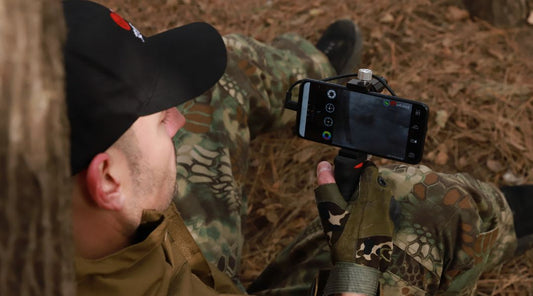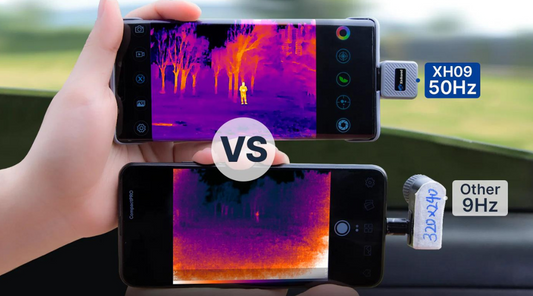Thermal Imaging Uncovered: A Beginner's Perspective
Welcome to the fascinating world of thermal imaging! If you're a beginner curious about this innovative technology, you've come to the right place. In this article, we will unravel the mysteries of thermal cameras from a beginner's perspective, exploring their benefits, applications, and how to get started. Whether you're interested in home inspections, energy efficiency, or wildlife observation, thermal imaging has something to offer. Let's dive in!

Benefits of Thermal Imaging for Beginners
Before we delve into the nitty-gritty, let's understand why thermal imaging is such an exciting field for beginners.
1. Detecting Temperature Variations
A thermal imager enables you to see temperature differences in objects and environments. It can help you identify problems such as heat leaks in your home, electrical issues, or even locate a lost pet in the dark.
2. Safety and Security Applications
Thermal imaging can enhance safety and security by detecting hidden threats. Firefighters use it to navigate through smoke-filled buildings, and law enforcement uses it to track down suspects at night.
3. Industrial and Scientific Uses
In the industrial and scientific fields, thermal imager is indispensable. It's used for predictive maintenance, medical diagnostics, and even in archaeological studies.
How Thermal Imaging Works
Understanding the basic principles of thermal imaging is crucial for beginners.
1. Infrared Radiation and Heat Detection
Every object emits heat in the form of infrared radiation. Thermal cameras capture this radiation, converting it into visible images. The hotter an object, the brighter it appears in the image.
2. Technology Behind Thermal Cameras
Thermal cameras use special sensors called microbolometers to detect infrared radiation. These sensors create a temperature map of the scene, allowing you to visualize temperature variations.
3. Components of a Thermal Imaging System
A thermal imaging system typically consists of a camera, a display screen, and often a user interface. Some modern smartphones even offer thermal imager capabilities through attachments.
Practical Applications for Beginners
Here are some practical applications where beginners can dive into the world of thermal cameras.
1. Home Inspections
Are you planning to buy a new home or renovate your existing one? Thermal imaging can help you identify insulation problems, water leaks, or electrical issues. It's like having X-ray vision for your home!
2. Energy Efficiency Assessments
Want to make your home more energy-efficient? Thermal cameras can pinpoint areas where heat is escaping, helping you save on heating and cooling costs.
3. Wildlife Observation
Nature enthusiasts will love using thermal imaging to observe wildlife at night. You can spot elusive creatures like owls, bats, and other nocturnal animals without disturbing them.
Choosing the Right Thermal Imaging Equipment
Selecting the right equipment is essential for beginners.
Different Types of Thermal Imaging Devices
- Handheld Thermal Cameras: These are portable and easy to use, making them suitable for beginners.
- Smartphone Thermal Attachments: Some smartphones offer thermal imaging as an attachment, providing an affordable option for entry-level users.
- Professional-Grade Thermal Cameras: These cameras are used in various industries and offer advanced features but come at a higher cost.
To get started, consider your needs, budget, and the types of projects you have in mind.
How to Interpret Thermal Images
Interpreting thermal images is an essential skill for beginners.
Color Palettes and Temperature Scales
Thermal cameras use color palettes to represent temperature variations. For example, hot areas may appear as red or white, while cooler areas appear as blue or black. Understanding these palettes is key to interpreting images accurately.
Identifying Anomalies and Patterns
As a beginner, it's essential to learn how to identify anomalies in your thermal images. Look for temperature variations that might indicate issues such as leaks, electrical problems, or wildlife.
Common Mistakes to Avoid
- Misinterpreting Images: Beginners often misinterpret thermal images, mistaking harmless temperature variations for problems.
- Focusing on Aesthetics: Don't get too caught up in the aesthetics of thermal images. Concentrate on the information they provide.
- Neglecting Calibration: Ensure your thermal camera is properly calibrated for accurate readings.

Maintenance and Care of Thermal Imaging Equipment
Taking care of your equipment is crucial for long-lasting performance.
Cleaning: Keep your camera's lens and screen clean for clear images.
Storage: Store your thermal camera in a protective case to prevent damage.
Calibration: Periodically calibrate your camera to maintain accuracy.

Resources and Further Learning
Ready to dive deeper into thermal imaging? You can do this in several ways:
Online Courses: Many online courses offer in-depth training in thermal imaging technology.
Books: Consider reading books that cover thermal camera principles and applications.
Professional Organizations: Joining a thermal imager professional organization can provide valuable networking and educational opportunities.
In this beginner's guide to thermal imaging, we've uncovered the fascinating world of infrared radiation, temperature maps, and the endless applications of this technology. Whether you're a homeowner, a nature enthusiast, or someone simply curious about the world of thermal imaging, there's a place for you in this exciting field. Remember, practice makes perfect, and with the right equipment and knowledge, you can unlock the full potential of thermal imaging.




